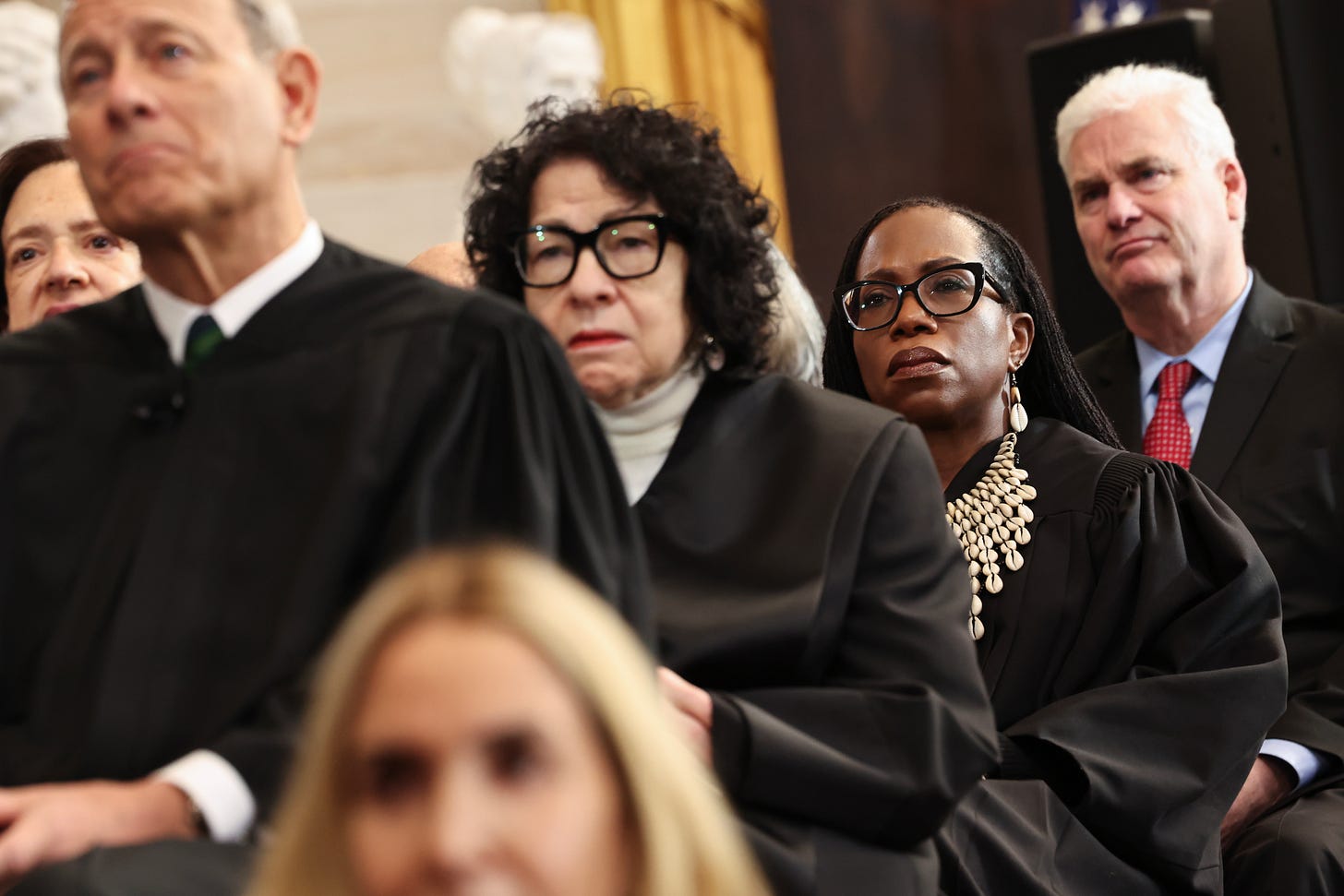SCOTUS pumps the brakes on Trump's lawless deportations
The administration's combination of malicious compliance and outright defiance is starting to wear thin.

✍️ ⚖️ ✍️ With corporate outlets obeying in advance, supporting independent political media is more important right now than ever. Public Notice is possible thanks to paid subscribers. If you aren’t one already, please click the button below and become one to support our work. ✍️ ⚖️ ✍️
The Supreme Court’s decision last Friday to swat down some of Trump’s worst deportation excesses is a limited victory for the rule of law and due process. But as has repeatedly been the case when the Court has tried to constrain the administration’s lawlessness, they’re left with plenty of room to continue pushing boundaries and terrorizing immigrants.
In a 7-2 unsigned opinion, the Court blocked the administration from using the Alien Enemies Act to remove Venezuelan men currently held in immigration custody in the Northern District of Texas, where the lower court case was brought. That’s not a permanent block or a lasting victory, though. All this means is that those people cannot be removed from the United States while the litigation proceeds.
It also means that the substantive question of whether it is legal to use the AEA to deport alleged Tren de Aragua members hasn’t been answered yet. The majority just urged the lower courts to address the various AEA cases “expeditiously” and sent this case back down to the Fifth Circuit Court of Appeals for that court to determine what notice must be given to people the administration intends to remove.
While the relief ordered by the majority is relatively minimal, it’s a fairly big deal how the Court applied it. The administration keeps trying to minimize the impact of its many losses, often by arguing that an adverse ruling should only apply to the named parties rather than a group of people or the entire country. Here, the Supreme Court granted emergency relief to a group of people, not just the plaintiffs in the case.
The decision protects a defined class of people — all Venezuelan men who the administration alleges are TdA members and can be deported under the AEA — who are presently in immigration detention in Northern Texas. Northern Texas is a huge district, covering Dallas, Fort Worth, Amarillo, and more.
This is unusual procedurally, but it’s really the only way to deal with this administration. While it’s good to see the Court taking bold action to provide widespread protection, its refusal to place strict limits on the administration or impose specific consequences for violating orders gives Trump far too much leeway. The only downside the administration has really faced thus far is that Department of Justice attorneys keep getting put through the ringer by lower courts who aren’t thrilled with the administration’s refusal to follow the law.
To be clear, this isn’t the “turn the planes around” case, but we wouldn’t have this case without that one. That case is Trump v. JGG, where the administration ignored Judge James Boasberg’s order and sent hundreds of Venezuelans to El Salvador’s notorious CECOT prison.
There, five conservatives on the Court threw the administration a lifeline, saying it could keep deporting people after providing “adequate notice” within “a reasonable time and in such a manner as will allow them to actually seek habeas relief in the proper venue before such removal occurs.”
This current case, AARP v. Trump, arose after the ruling in JGG, alleging that the administration was not giving adequate notice as required. The administration decided that 12 hours to determine whether to file a habeas petition and 24 additional hours to file with the court was adequate and reasonable. That’s absurd, particularly given that the administration often removes detainees from where they live and immediately sends them to ICE facilities in conservative strongholds like Louisiana.
Substantively, the AARP case is about whether Trump can use the AEA to remove Venezuelans it alleges are members of TdA. Procedurally, however, the case is also about whether the 12-hour/24-hour notice framework was adequate due process and whether even that meager amount of time was actually being given. The complaint also sought to create a class for habeas relief so that detainees did not have to bring their habeas claims individually.
Lawyers for the plaintiffs asked the court to certify a proposed class of all noncitizens in custody in the Northern District of Texas who are subject to removal under the AEA proclamation regarding TdA. Unsurprisingly, the administration opposed the request.
A note from Aaron: Working with fantastic contributors like Lisa takes resources. If you aren’t already a paid subscriber, please sign up to support our work.
When AARP arrived at the Supreme Court for the first time in April, it led to a super-dramatic midnight order blocking the government from removing “any member of the putative class of detainees.” That ruling isn’t saying that such a class exists, but just barring the removal of anyone who falls in that class.
All of this brings us to last Friday’s decision. Much of the reason this opinion had to exist and sweep broadly is that the administration has treated court orders with a nightmare combination of malicious compliance and outright defiance. The comically short notice timeframe is a great example of the former. The administration can’t be said to be defying that order — it created a process! See! — but its proposed adherence to it is completely inadequate.
The administration’s behavior is also what necessitates the class action approach. The government could simply agree not to remove anyone while litigation over the AEA proceeds, regardless of whether that person joined this case or that. But that’s not what they want. They want to deport as many people as possible before a final ruling from the Supreme Court on the AEA. Indeed, Friday’s Supreme Court opinion justified the need for emergency action in part on the administration’s refusal to return the wrongfully removed Kilmar Abrego Garcia.
“Had the detainees been removed from the United States to the custody of a foreign sovereign on April 19, the Government may have argued, as it has previously argued, that no US court had jurisdiction to order relief,” the Court’s opinion reads.
The Court also held that giving detainees roughly 24 hours of notice before removal, “devoid of information about how to exercise due process rights to contest that removal surely does not pass muster.” However, the Court still won’t define what due process is owed or what adequate and reasonable notice would be, instead kicking it back down to the Fifth Circuit for further proceedings. The end result of all this procedural maneuvering is that Venezuelans being held in the Northern District of Texas as alleged TdA members are temporarily protected from removal while the administration continues to fight about how much notice it has to give.
But even this meager, limited relief makes Justices Samuel Alito and Clarence Thomas furious.
Alito and Thomas are down for Trumpian autocracy
Alito’s dissent is a curious thing, as he is typically aggressive about asserting that no other branch can possibly tell the mighty Court what to do. Remember how tough he talked when Congress had the temerity to suggest that maybe there should be an ethics code that barred the justices from taking millions in gifts from billionaires?
“I know this is a controversial view, but I’m willing to say it. No provision in the Constitution gives them the authority to regulate the Supreme Court — period,” Alito told the Wall Street Journal.
When it comes to letting the executive branch run roughshod, though, all of a sudden, the Court is a powerless little guy, according to Alito.
The Supreme Court, he says, has no jurisdiction and therefore no authority to issue any relief. If you take Alito at face value, his ostensible concern here is that this was too hasty, that the underlying litigation hadn’t played out: “It [the Court] has plucked a case from a district court and decided important issues in the first instance. To my eyes, that looks far too much like an expansion of our original jurisdiction.”
Alito also doesn’t see what the big deal is, as the government pinky-swore it wouldn’t remove the two named plaintiffs while the case proceeds, and since they’re protected, no harm, no foul. His stance would just let the administration deport everyone else unless they, too, can successfully obtain some sort of temporary habeas relief by fighting a relentless government all the way up to the nation’s highest court.
And if the Supreme Court ultimately ruled that removing people under the AEA was never proper? Alito is fine with creating hundreds, if not thousands, of Abrego Garcias, wrongfully removed forever after the administration inevitably argues it cannot bring them back.
One would think Sam Alito would also be furious about how the executive branch is treating a decision of the nation’s highest Court. Shortly after the decision on Friday, Trump went on Truth Social for a bit of all-caps yelling: “THE SUPREME COURT WON'T ALLOW US TO GET CRIMINALS OUT OF OUR COUNTRY!”
Alito, after all, is the same justice who couldn’t abide former President Obama’s mild criticism of the Court’s Citizens United decision during the 2010 State of the Union, mouthing “not true” like a pouty child. A president calmly expressing disagreement with a Supreme Court decision in a political setting: untenable and beyond the pale. But a president yelling about a Supreme Court decision on his private social media network? It’s apparently not even worth remarking upon.
Although it already feels like an endless slog, all AEA cases are in their earliest stages. We’re so, so far away from a final Supreme Court decision that gives a thumbs up or a thumbs down to Trump’s attempt to forcibly remove people based on the flimsiest of allegations about gang membership. Meanwhile, the administration will keep looking for loopholes, trying to get around the court orders that keep telling them to knock it off.
Or perhaps the administration will, as Stephen Miller has suggested, just suspend habeas, cutting the courts out of the procedure entirely. We’ll see if Sam Alito is so sanguine about Trump’s power grab if that happens.
That’s it for today
We’ll be back with more tomorrow. If you appreciate today’s newsletter, please support our work by signing up. Paid subscribers make Public Notice possible.
Thanks for reading, and for your support.






Somehow, I fully expect Alito to be just fine with suspending Habeas.
Justice Sam Alito should be ashamed and shamed for his position which would allow Trump to run roughshod over the Constitution.